

Line 2 : Vanguard prevented.
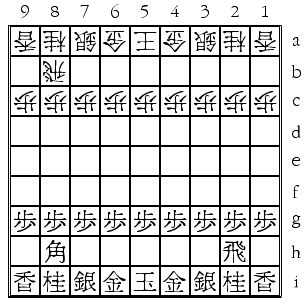
Starting position
1... S6b 2 P7f P5d 3 P6f P6d (Prevents the vanguard pawn, but gives black a target) 4 R6h S5c (4... S6c below is probably better, to foil the following plan) 5 P9f (Planning a direct attack on the 6d pawn by B9g. It turns out to be quite difficult for white to counter this plan from here.) G4a5b 6 B9g (This seems risky in view of the danger of P9d-9e, but this can usually be met by an exchange of the bishop for silver plus lance) G6c 7 N7g S3a4b 8 P6e R6b

After 8... R6b
(not 8... Px6e? 9 Rx6e P*6d 10 R2e) 9 S7h K4a (and now not 9... Px6e? 10 Nx6e S6d 11 Bx6d Gx6d 12 S*5c) 10 K4h K3b 11 K3h G5b 12 Px6d (now that the 5c square is adequately defended, white was threatening to capture on 6e) Sx6d 13 S6g P7d 14 S5f S6d5c (This retreat is not forced, but aims at either P*6d or P9d-9e, since the exchange of bishop for silver and lance is much less effective with the silver on 5c than on 6d. If white just leaves things alone, black can complete his Mino castle while white can't do much.) 15 G65h P9d 16 N6e S6d

After 16... S6d
(16... S4d 17 P*6d Gx6d 18 N7c+Nx7c 19 Rx6d makes profit) 17 Bx6d! Gx6d 18 S*7c R6c (18... Nx7c 19 Nx7c+ R6a 20 P*6b wins the gold on 6d) 19 S7b= R6b 20 Sx8a= (note how it's usually best not to promote a silver on the last two ranks, as a silver has twice as many retreating moves as a gold. Now black threatens 21 N7c+ R6a 22 S7b=) B*8d (guards the threat, but the bishop is now a target. If instead G56c 21 N*8e) 21 P8f R8b (21... P5e 22 P8e B9c 23 N7c+) 22 N7c+!!

After 22.N7c+!!
(a nice tactic) Bx7c 23 N*8e B8d 24 Rx6d Rx8a 25 P*6c (Black has lost bishop for gold, but his threats of G*7b or Rx7d are hard to meet).
Variation 1
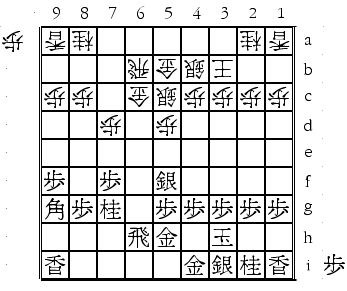
After 15.G65h
15 ... P*6d 16 P*6e N7c (16... Px6e would be one tempo worse than above line) 17 Px6d Sx6d (17... Gx6d 18 Bx6d! Sx6d 19 P7e B*4d 20 Px7d Bx7g+ 21 Px7c+ Sx7c 22 Rx6b+ Sx6b 23 P*6c S6b5a 24 N*6d Gx6c 25 N5b+ Sx5b 26 R*7b forking horse and silver) 18 N6e Nx6e 19 Sx6e Sx6e 20 Rx6e P*6d 21 R8e R8b
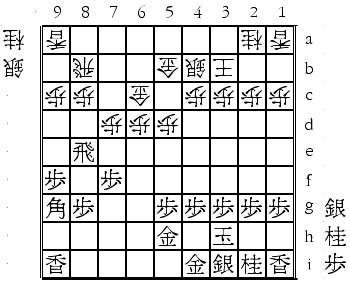
After 21... R8b
(21... G7c 22 P7e P8d 23 Px7d Gx7d 24 R2e R6a 25 N*6f G6e 26 Nx5d S5c 27 Rx6e Px6e 28 Bx5c+ Gx5c 29 S*6b) 22 P*6e N*7c (22... Px6e 23 N*6d) 23 Px6d Nx8e 24 Px6c+ Nx9g+ 25 G*7c R9b 26 +Px5b Rx5b 27 P*6c P*6a 28 P6b+ Px6b 29 N*6d R5c 30 Gx6b and the threat of N5b+ gives black the advantage.
Variation 2 : Quick attack prevented.
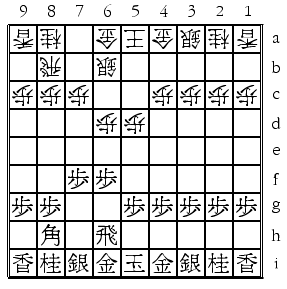
After 4... R6h
4... S6c (best, I think) 5 S7h (the P9f and B9g attack is not good here because after a later Nx6e S5c6d Bx6d Sx6d the silver guards the squares that the knight attacks, whereas a gold on 6d does not.) S4b 6 K4h S5c 7 S3h K4b 8 K3i (This method of castling, rather than K3h-2h before S3h, is preferred when an early attack using the right knight is planned, to save a move and because sometimes the king will stay on 3i or go to 2i since on 2h it may be vulnerable to a later attack on 3f by knight or pawn) G6a5b 9 P4f P4d 10 P6e Px6e 11 Rx6e P*6d 12 R6h G4c 13 P3f G5b 14 S6g P8d 15 S5f P8e 16 B7g P7d 17 N3g N7c

After 17... N7c
(This is better than 17... K3b which is met by 18 R4h N7c 19 G6i5h P6e 20 P4e Px4e 21 Nx4e S4d 22 Bx4d! Gx4d 23 S*5c. Note that this is almost a mirror image of the quick attack main line above. This type of attack works against silver and gold but not against two silvers. Since white cannot guard both 6d and 4d with two silvers, black attacks whichever point has only one silver defending.) 18 G6i5h (now 18 R4h P6e 19 G6i5h is met by 19... P6f) P9d (now or later ... P6e or ... N6e are met by Sx6e; although black loses silver for knight and pawn, nominally a loss, the lack of any white pawn to block out the rook makes this good for black. This is a very important point.) 19 G4g (19 P9f would be inconsistent with the plan of attacking 4d) P9e 20 K2h (now that 3f is defended this is appropriate) P1d 21 P1f K3b 22 P2f (since white makes no threat, black plays every useful move before attacking) with several branches :

After 22.P2f
Branch A: 22... P7e 23 Px7e N6e 24 Sx6e Px6e 25 Rx6e S*7f 26 R6h Sx7g+ 27 Nx7g
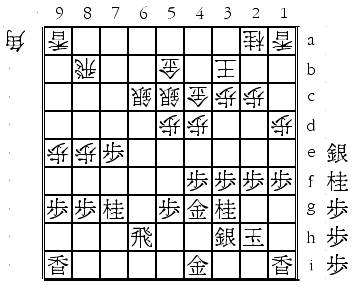
After 27.Nx7g
and despite white's bishop for knight and pawns profit, black's threat of P7d, his pieces and pawns in hand, and white's lack of any pawn in hand give black the edge. But if white plays ... R8d or ... R8a first, this will be a real threat.
Branch B: 22... R8d 23 P4e (else 23... P7e) Px4e 24 Nx4e S4d (24... P*4d 25 Nx5c+ G5bx5c 26 S*6b N6e 27 B6f wins gold for knight) 25 Bx4d! (again this tactic, the theme of this whole vanguard denied line) Gx4d 26 S*5c Gx4e 27 Sx5b= Sx5b 28 Sx4e
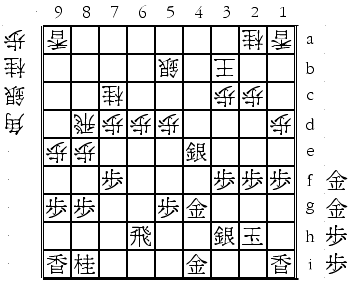
After 28.Sx4e
(this exchange of bishop and knight for two golds is about even materially, but white has lost his castle) B*5e 29 P*4f Bx9i+ 30 G*6b S*4c (30... S4c 31 Rx6d) 31 Sx5d (if white had played 22... R8a instead of R8d black would now prefer 31 Rx6d +B5e 32 Gx5b +Bx6d 33 S*5c Sx5b 34 G*4b K2b 35 Sx6d+ R*6h 36 B*7b R8d 37 Bx5d+ with a winning attack) +B4d ("bring the Horse home" is a proverb) 32 Gx5b Sx5b 33 Rx6d N*7b 34 S*4c Sx4c 35 Sx4c+ +Bx4c 36 R6b+ followed by taking the knights favors black due to his dragon and much better castle.
Branch C: White attacks first. 22... P5e 23 Sx5e N6e 24 B6f P8f 25 P4e Px8g+ 26 Px4d G4c4b 27 N4e S6b 28 P3e P*8h (28... +P8f 29 R8h P*8g 30 R7h +P7g 31 P*8c Rx8c 32 P*8d with advantage) 29 P3d Px3d 30 S4f L1c 31 P4c+ G5bx4c 32 B1a+ P*4d 33 P*3c K3a 34 Rx6e!
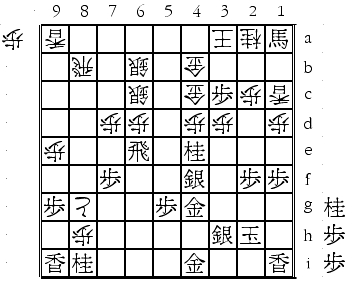
After 34.Rx6e!
Px6e 35 N*5e S5d 36 Nx4c+ Sx4c 37 S5e Px4e 38 P*4d S5b 39 S5d P*5c (39... Nx3c 40 G*4c or 39... N*5a 40 G*2b) 40 P4c+ in all cases with a huge attack.